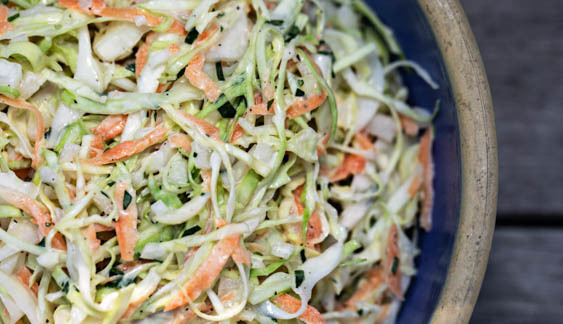Coleslaw

introduction
The chief requirements of any coleslaw are that it be crisp, cold, tangy, and quenching. Much of that comes down to how the vegetables are handled. This is this way I (Kay) make coleslaw. Yes, the steps are pain in the ass, and the knifework requires skill and precision, but this slaw collects raves whenever it shows up.
Cooking Remarks
A good slaw needs a sharp well-balanced knife, as well as a careful knife operator. The food processor won’t produce this kind of slaw.
The idea behind the ice-water brine is to crisp up and season the cabbage. We started using this method after working on kimchi. A separate, smaller amount of ice-water brine also crisps up and seasons the minced onion and washes away any harsh flavor that even so-called sweet onions carry.
equipment mise en place
For this recipe, you will need a digital kitchen scale, a large bowl and a small bowl, 1½ pounds ice, a very sharp chef’s knife, a wire skimmer, a box grater, a colander, a clean kitchen towel, and a fine-mesh sieve.
-
-
Fine sea salt
-
¼cup boiling water
-
3cups spring or filtered water, room temperature
-
1½pounds ice
-
1medium head (about 2 pounds) green cabbage
-
1small (about 6 ounces) sweet onion
-
3medium (about 10 ounces) carrots
-
3tablespoons chopped fresh flat-leaf parsley
-
Freshly ground black pepper
-
6ounces Homemade Mayonnaise
-
1tablespoon juice from 1 juicy lemon
-
2teaspoons sugar
-
-
Measure 0.4 ounce salt into a large bowl. Add the boiling water and stir until the salt dissolves. Pour in the room-temperature water and add the ice. Scoop out about 1 cup of the ice-water brine and pour it into a small bowl; set both bowls aside.
-
Using a very sharp chef’s knife, cut the cabbage in half from top to bottom. Remove and discard any tough or bruised outer leaves. Cut the cabbage halves into relatively small wedges (fig. 2.1), cut off and discard the core from each wedge, and shave the cabbage into thin ribbons (fig. 2.2). When you have 1 pound of sliced cabbage, turn it into the large bowl of brine. Mince the onion and turn 3 ounces of it into the smaller bowl of brine. Peel and trim the carrots, then shred them on the large holes of a box grater. Weigh out 6 ounces of shredded carrots and set them aside.
-
After 30 minutes or so, use a wire skimmer to pull out as many ice cubes as possible from both the cabbage and onion, then drain the cabbage in a colander set in the sink. Pick out any remaining ice. Shake the colander and toss the cabbage to drain it well, then blot it with a clean kitchen towel, tossing it as you blot. Dry the bowl used to brine the cabbage and return the cabbage to it. Now pick any remaining ice out of the onion and drain in a fine-mesh sieve. Shake well, then blot lightly with the towel; the onion will have swelled. Add ⅓ to ½ cup of the onion (depending on your taste) to the cabbage, along with the carrots, parsley, and ½ to ¾ teaspoon pepper; toss well.
-
In a small bowl, stir together the mayonnaise, lemon juice, and sugar. Pour the mixture over the vegetables and toss well. Taste for seasoning. You probably will not need additional salt. Just-made coleslaw tastes best but leftovers will be very welcome, too. (Leftovers will keep in an airtight container in the refrigerator until they’re gone.)
-
-
2.1

-
2.2

-